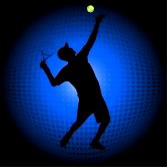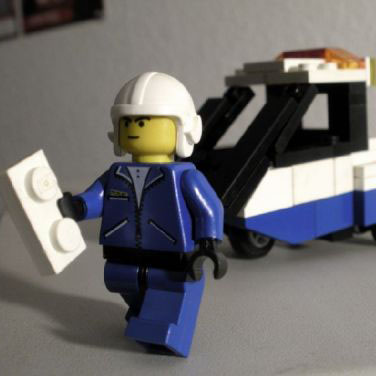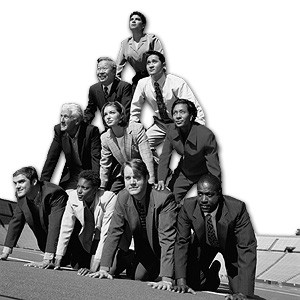
SGTennis
Bradenton, FL
Male, 24
After completing my four years at a division one college tennis program, I went on to compete on various professional tennis circuits nationwide. Between traveling, training, and competing, little time is left in between stages. Thus, routines and rituals rule my life. All of the matches are won in-between the lines, but the most challenging work is done outside of them. "A perfect combination of violent action taking place in an atmosphere of total tranquility." - Billie Jean King
Unfortunately, mostly all you can do is complain to the official and let him hear your case. If the professional event is lucky enough to be able to afford the "shot spot" technology then you can challenge the officials call(limited number of these per set) and a very slow, zoomed in view of the shot is reviewed and the system confirms or denies the officials call. The technology is still a very recent innovation, but is proving its worth and has almost full support from the professional community at this point. All tennis players can attest to inquiring about the real truth behind an opponents call. Had I been able to use this technology my whole life, I would have avoided thousands of confrontations with opponents!
Sure. Some of the best pros in the world were taught by one individual or a family member until sometimes very late stages(age 13-14+) of their development. Growing up in Bradenton, FL since age 12 I was surrounded by the factory academies(IMG, Saddlebrook, etc). They are a great resource for most players looking to develop their game but if you tend not to enjoy being herded around like cattle, I would recommend a more private experience. I was able to find a small-medium size camp that I loved due to similar, if not better coaching than IMG could provide with more personal attention. Sure, if you can afford to pay Nick Bolletiere his $1000/hr price than you would get world class eyes and advice on your strokes. If you look up three random professional players in the top 50, they would all most likely have a very different experience through their childhood tennis training years. Dedication, training, fitness, and competition are the key elements to success in tennis. If you can check all four of those off on a regular basis, your game will dramatically improve. If you want to amp up your ability even more start focusing on your diet, and begin a stretching regiment. Try a hot yoga class, you'll never sweat so much and you'll leave more limber.
Yes. Now let me explain. I'll break it down into three main differences between the level of men's and women's PROFESSIONAL tennis. 1. The Serve - The most crucial shot in tennis and the shot with the largest difference in performance from a male to a female. ATP(Men) player's first serve speed can reach 150mph, but usually averages around 115-125mph. WTA(Women) player's first serve can reach 125mph, with an average usually around 90-105mph. The speed difference alone changes the dynamic of the beginning of the point. Less reaction time, more ground to cover in less time, and all the attributes that go along with a faster first shot. This leads into point number 2. 2. Court coverage - The next time you watch tennis, consider the ground covered by each opponent during the point. Now consider each competitor as a soccer goalie whose only(basically) job is to keep the ball in front of them without letting it past. Now imagine that one goalie can cover 20 feet side to side at any given time but the other can cover 25 feet in the same time. Now double that difference since you can be exploited both side to side and front to back on the court and you'll begin to see where the holes in the court appear. The holes I'm speaking off are the areas where the female would be unable to get to that next shot to continue to point. 3. SPIN - Can't say enough about this tricky part of tennis. Spin is powered by strength and power, similar to the speed of the ball. So when considering the serves for instance, the female game has a few who utilize the kick(spin) serve well but in the men's game it is a staple of almost all players. This allows the player to not only put the ball higher up on the returner but also farther away from them. In review, the most important shot in tennis is 20-25 mph different from the men's to women's game. Pro men can cover approximately five more feet in any direction at any given time. Last but not least, spin is utilized on a completely different level by men and provides a foreign element that is non-existent in the women's game today. Simply put, every top 1000 ATP mens player will beat every women in the top 10 of the WTA due to the fact that the speed, court coverage, and spin are that of a player the Women's game has never seen. Yes, Serena is a powerful beast. But she is slow...and any men's professional player would immediately exploit that. **When I was 16, I played a practice match versus a top 500 WTA player training with my camp for the week. Exactly in those three areas is where I found my advantage. My serve(the power then the spin), and my court coverage compared to hers. I would love to see the women's game adapt to a best out of five set format for the majors like the men. You don't see marathon running women run 60% of the race then stop. The same should apply for tennis. I agree with equal prize money, but you should have to earn that.
Double groin pull. Slid into a shot at full stride only to lose basic function of my legs for weeks. Very painful, however a close second place goes to losing control of my racket after a serve only to have it bounce of the hard court and drill my throat at full force.
Meter Maid
 Is it tough to have a job that consists exclusively of ruining peoples' days?
Is it tough to have a job that consists exclusively of ruining peoples' days?
Call Center Employee (Retail)
 I've heard that a lot of startups are hiring really well-educated college grads and paying them a lot, reasoning that customer service is often a client's most lasting impression of a brand. What do you think, and is it something you see spreading?
I've heard that a lot of startups are hiring really well-educated college grads and paying them a lot, reasoning that customer service is often a client's most lasting impression of a brand. What do you think, and is it something you see spreading?
HR Executive
 How do you feel about employees working remotely?
How do you feel about employees working remotely?
I have seen more parents fight than competitors. Many pushing matches, but no full on player on player fights. However, I did get sucker punched once after a match. I get into the matches, and I fight for my rights on the court. When I suspect someone of cheating me, it gets personal. I was about 15, playing in a high level sectional event in FL and after beating a notorious cheater somewhat easily(and for the first time in three attempts), I let him hear it. He had tortured me with dishonest calls for years now and I was ready to tell him that era was finished. After jawing with him back and forth to the pro shop, I set my things down and turned away to watch a friend play. Next thing I know, I got socked in the head and he is running to the parking lot cursing me out. My coach held me back from chasing him down, which was smart for my tennis career and probably also my face...The USTA suspended him for a year and I never faced him again.
Regarding doubles from a mental standpoint, communication is key. As opposed to singles, where there is no one but yourself to deal with. Physically, players of all sizes have found success with both singles and doubles but especially in doubles length and quick, explosive movement rules all.
In the first round of NCAA competition, my freshmen year Brown University team matched up against a highly ranked Notre Dame team in 2006. With the match tied at 3-3 and all other matches completed, we watched as a teammate went through full body cramps only to eventually lose in a close three-set match. It would have been the program’s biggest win in twenty years or so. Heartbreaking every time I think about it!
There are all sorts of sponsorships from even simple discounts from various manufacturers to full-on, “we will send you anything you want, anytime.” Sponsors are generally looking for long-term impact so they have a tendency to target the most talented, youngest players available. Sometimes it can be a game of who you know, but anyone who is consistently able to compete at the challenger level will be able to attain multiple sponsorships.
Tough question but my gut says Roger Federer. Most number of majors won, most consistent of anyone out there. Players can get hot as Novak Djokovic did over the last season but I see Roger continuing on his record setting career with more major grand slam wins.
While tennis at the highest level has quite a following, the term "groupies" would be used rarely to describe many of the Futures or Open level tournaments. However, from tournament to tournament, the interest and fan support is different at each club or site. However, not having fans for many of the matches makes it all the more thrilling when you are able to play in front of hundreds of engaged fans of the sport.
Yes, many times. My most regrettable outburst was in a college match vs. Stanford. I was in a tie-breaker in the third set and I lost a point to go down 6-5 and I yelled..."Fuuuuu***..." but didnt exactly finish out the curse word. Regardless, the official gave my point penalty for the obscenity which ended the match. I pleaded my case of saying half(ok maybe 2/3's of the word) but he heard none of it. Worst part was this was a live streaming match through Stanford's website and many family members were watching....Not my brightest moment. One match after many disagreements with an official, I accidentally smacked a return aggressively and hit the official in the ear with a 80+mph shot. He was so emotional about getting hit that he tried to default me from the match since he thought I meant to hit him. Another official calmed him down and they gave him the rest of the day off. He was fine and I never saw that official again...I hope he didn't quit because of that.
I currently play both singles and doubles. Each game is quite unique and equally challenging. It is hard not to love the ultimate battle of one person versus another but doubles brings an increased pace which I prefer. Also, over my life of tennis my highest achievements have come from the doubles court, so my opinion will naturally sway in that direction!
For most players the act of fiddling with their strings is a ritual to keep them focused on the match and not on any distracting factors. However after a long point, or sometimes randomly the string pattern can move around a bit which can change the rackets feel quite a bit. And yes, some pros will use their racket as the scapegoat on almost every missed shot. However, you won't see them praising their racket when they hit an amazing shot.
Great question. I believe they intended to increase excitement for the game by allowing stronger materials to be used in the formation of the racket. It definitely did for some, but I believe it turned off a significant viewership of baby boomers who would like to watch Bjorg-McEnroe(ping-pong style tennis) for the rest of their lives. In the game today, we see a final like last Sunday involving John Isner and Roger Federer. One brute power and length, Isner - versus control and marksmanship, Federer. The technological advancements have altered the game and shots deemed impossible before are now...well you get the point. The largest change in the game due to technology is the level of strength and fitness that is necessary to succeed at this level today. Since the ball moves faster, the pace of play increases and thus every aspect of the game is intensified. Footwork needs to be quicker, mind needs to think faster, and the body has to exert more physical power to stay in a rally, let alone win said rally. So with technological advancements, we have created in my mind a better game. A game that is faster, more explosive, more intriguing, and an even tougher test of mental and physical strain on all competitors. Regarding coaching on the court, I wouldn't be opposed to it. I went through coaching on the court during Div. 1 collegiate play and enjoyed the extra set of eyes. But lets be honest, most people are getting coached from the stands anyway... What I'd like to see in terms of innovating the sport: Get the fans as close as possible - extra seating, courtyard seating like in basketball, etc. Music during the match could be interesting but probably will never be received well because players use the sound of the ball coming off the racket to determine qualities about the shot coming their way. AT LEAST play some music on the changeovers when everyone is waiting anyway(some tournaments have adopted this, but not nearly enough) Continue to implement the shot spot system, it engages the crowd and allows the players a stand against umpires Can I request cheerleaders? for no particular reason..
As my professional career has recently begun, I revert back to my team tennis experience at Brown University. My freshmen year I was immediately thrust into conference play and somewhat randomly and due to the length of my match, I found that all the eyes had shifted to my own court. I was able to win a close one to clinch the ivy league title for our squad in 2006.
I would estimate that the players I compete with on a week-to-week basis at the Open/Futures/Challenger level tournaments would make from $15,000-$50,000. The key is to get sponsored, so at least all of the tennis-related expenses are taken care of.
After playing division one collegiate tennis and graduating, I decided to move directly to NYC and pursue a life without sports. After a summer internship with a beer distributor, I again came back to tennis and taught for nearly eight months in NYC before requiring major surgery on my back. Following the radiation, rehab, and recovery, I began to feel a sudden urge to compete after being forcibly unable to exercise for nearly nine months. I realized at the age of twenty-three, my time was limited and I jumped in with both feet.
I would probably still be working in the real estate sector (which I left to pursue my tennis career), primarily leasing residential and commercial spaces in NYC. Also, I would be able to allocate more time to the start-up vending machine business my partners and I have been working on since last year.
Every player is different. From what they need, to how they prepare, to what they do the second they finish a match. If I had to put a minimum on hours per week that you must spend ON THE COURT to have a chance competing, it would be around 15hrs/week. However, I've witnessed upwards of 30 hrs/week from the real work horses but that is truly rare. To put it simply, if you had a day job you'd spend approximately 35-40 hours dedicated to that practice. Tennis is no different. If you spend 30-40 hours/week of court time, gym time, track time, and the ever important stretching time you'll be headed in the right direction.
Absolutely. Unfortunately, it is very expensive and not all professional tournaments will be able to adopt it for quite some time. I am in full support for its ability to give the player a voice on the court rather than the head official reigning supreme over all calls. This is essential, and all the pros enjoy the ability to exercise this right when available. Also, it engages the crowd. Fans are able to guess on the calls before seeing the slow motion replay and it provides added excitement to the live experience.
-OR-
 Login with Facebook
Login with Facebook (max 20 characters - letters, numbers, and underscores only. Note that your username is private, and you have the option to choose an alias when asking questions or hosting a Q&A.)
(A valid e-mail address is required. Your e-mail will not be shared with anyone.)
(min 5 characters)
By checking this box, you acknowledge that you have read and agree to Jobstr.com’s Terms and Privacy Policy.
-OR-
 Register with Facebook
Register with Facebook(Don't worry: you'll be able to choose an alias when asking questions or hosting a Q&A.)